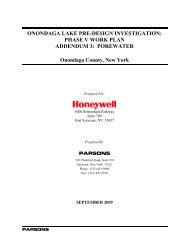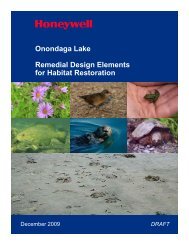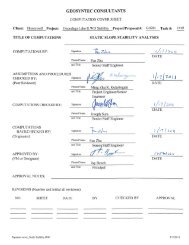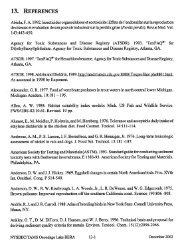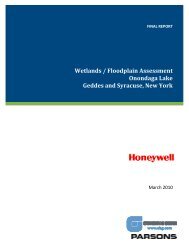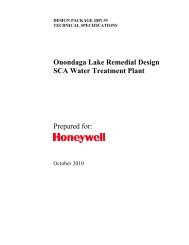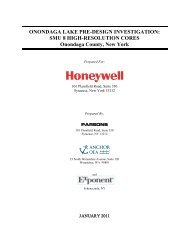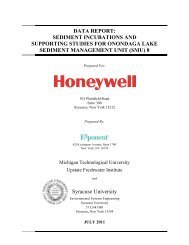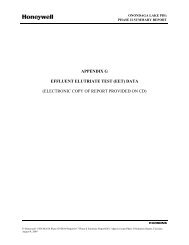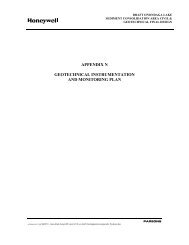Phase 1B Underwater Archaeological Report for the Onondaga ...
Phase 1B Underwater Archaeological Report for the Onondaga ...
Phase 1B Underwater Archaeological Report for the Onondaga ...
Create successful ePaper yourself
Turn your PDF publications into a flip-book with our unique Google optimized e-Paper software.
FINAL<br />
<strong>Phase</strong> IB <strong>Underwater</strong> <strong>Archaeological</strong> Resources <strong>Report</strong> <strong>for</strong> <strong>Onondaga</strong> Lake Superfund Site<br />
Anomaly 4-1: Dump Scow<br />
Anomaly 4-1 Summary Table<br />
Anomaly Identification Wooden Dump Scow; NY Site Number 06740.012294<br />
Remedial Impact<br />
Dredge and Cap<br />
NRHP Eligibility<br />
Eligible as Contributing Property to Syracuse Maritime Historic District<br />
Recommendation<br />
Anomaly Dataset<br />
Side Scan (2005) 0308<br />
Magnetometer (2005) 743, 777<br />
Side Scan (2010) 6/3/10<br />
Sector Scan (2010) 6/4/10<br />
ROV Video Footage (2010) 6/9/10<br />
Diver Observations No<br />
Diver Videography<br />
No<br />
Maps/Charts<br />
Yes<br />
Aerial Imagery<br />
Yes<br />
Historic Accounts<br />
No<br />
Research Results<br />
A4-1 is an edge-fastened scow barge which is preserved up to <strong>the</strong> deck level, although <strong>the</strong> deck is no<br />
longer present. The vessel is 78 feet (23.77m) long and 27 feet (8.23m) wide. A wreck marker appears<br />
in <strong>the</strong> vicinity of A4-1 on a 1942 navigational chart (see Figure 37). The barge rests in shallow water just<br />
off shore, and adjacent to ano<strong>the</strong>r barge, A4-2 (Figure 43, Figure 44 and Figure 45). The archaeological<br />
data suggests that <strong>the</strong> barge’s build date is in <strong>the</strong> early twentieth century. The uppermost portions of<br />
<strong>the</strong> vessel are just below <strong>the</strong> water’s surface. The vessel’s hull structure suggests that it is a dump scow.<br />
During <strong>the</strong> <strong>Phase</strong> <strong>1B</strong> fieldwork, excellent surface visibility conditions allowed a detailed visual inspection<br />
of <strong>the</strong> barge’s interior structure. The barge’s principal extant members are its vertical, edge-fastened<br />
sides; longitudinal bulkheads; scow ends; transverse bulkheads; and framing. The barge’s interior is<br />
divided by two longitudinal bulkheads which run <strong>the</strong> length of <strong>the</strong> barge, compartmentalizing <strong>the</strong> vessel<br />
in to three sections. The hull is fur<strong>the</strong>r split up by three transverse bulkheads which span <strong>the</strong> breadth of<br />
<strong>the</strong> hull. Three shorter transverse bulkheads which span only <strong>the</strong> outboard longitudinal compartment<br />
were also noted. Framing is placed every +/- 4 feet (1.22m) with futtocks approximately 6 inches<br />
(15.24cm) moulded and sided. The two longitudinal bulkheads are about 8 inches (20.32cm) thick, <strong>the</strong><br />
transverse bulkheads are 6 inches (15.24cm) thick, while <strong>the</strong> sides are only 4 inches (10.16cm) thick.<br />
The discrepancy between <strong>the</strong> thickness of <strong>the</strong> sides and bulkheads suggests <strong>the</strong>re was considerable<br />
stress in <strong>the</strong> middle of hull and less at <strong>the</strong> sides.<br />
The original function of <strong>the</strong> barge could be deduced based on an examination of <strong>the</strong> structural<br />
components found in its middle longitudinal compartment. The compartment is bounded by<br />
longitudinal bulkheads, and <strong>the</strong> interior of each bulkhead has horizontally oriented cylinder shaped<br />
timbers paralleling <strong>the</strong> interior sides of each bulkhead. The cylinder shaped timbers have round sheaves<br />
attached to <strong>the</strong>m. One compartment also has an angled timber wall running parallel to <strong>the</strong> bulkhead.<br />
These features suggest <strong>the</strong> barge is a dump scow with <strong>the</strong> central longitudinal compartment serving as<br />
an opening to <strong>the</strong> waters below. The angled wall is a dump door with <strong>the</strong> sheaves and cylinder shaped<br />
timbers used to control <strong>the</strong> opening and closing of <strong>the</strong> door. Dump scows were used to dump cargoes<br />
into water bodies. They commonly carried stone, garbage or dredge spoil. The adjacent barge (A4-2)<br />
and a barge to <strong>the</strong> north (A3) also appear to be dump scows, although <strong>the</strong> construction techniques of<br />
63



